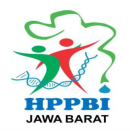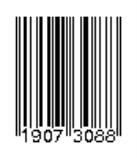Studi Kerapatan Kerang Kima (Tridacnidae) Di Pulau Pramuka dan Pulau Belanda, Kepulauan Seribu, DKI Jakarta.
Abstract
Keywords
Full Text:
PDFReferences
Adi, N. D., Damar, A., Adrianto, L., & Sudarma dan Akhmad Solihin, D. (2017). Strategi Pengelolaan Terumbu Karang Di Kepulauan Seribu. Jurnal Pengelolaan Sumberdaya Alam Dan Lingkungan, 7(3), 244–250. https://doi.org/10.19081/jpsl.2017.7.3.244
Braley, R. D. (1992). The Giant Clam:Hetchery and Nursery Culture Manual. Australia: ACIAR Monograph.
Castro, P., & Huber, M. E. (2008). Mariene Biology (Seventh Ed). New York: McGraw-Hill.
Fachrul, M. F. (2007). Metode Sampling Bioekologi. Jakarta: Bumi Aksara.
Ghufron, H., & Kordi, K. M. (2011). Ekosistem Lamun (seegres). Jakarta: Rineka Cipta.
Hasni, Sadarun, B., & Ira. (2017). Keanekaragaman dan Kepadatan Jenis Kima di Perairan Pulau Wawosunggu Kabupaten Konawe Selatan. Sapa Laut, 2(4), 113–118.
Hermawan, U. E. (2012). Taxonomy of Indonesia Giant Clams(Cardiidae,Tridacnina). Pusat Kelautan Oseanografi LIPI. Jurnal Biodiversitas. Vol. 13 (3): 118-123., 13(3), 118–123.
Lucas, J. S., & Copland, J. W. (1988). Giant Clams in Asia and the Pacific. Canberra: ACIAR Monograph Series.
Marzuki, I. D., Sadarun, B., & Palupi, R. D. (2013). Kondisi Terumbu Karang dan Kelimpahan Kima di Perairan Pulau Indo. Jurnal Mina Laut Indonesia, 1(1).
Neo, M. L., Wabnitz, C. C. C., Braley, R. D., Heslinga, G. A., Fauvelot, C., Van Wynsberge, S., … Todd, P. A. (2017). Giant clams (Bivalvia: Cardiidae: Tridacninae): A comprehensive update of species and their distribution, current threats and conservation status. Oceanography and Marine Biology: An Annual Review, 55(1965), 87–154. https://doi.org/10.1201/b21944
Noviana, L. (2018). Studi Ekosistem Terumbu Karang di Taman Nasional Kepulauan Seribu. Jurnal Pengelolaan Sumberdaya Alam Dan Lingkungan (Journal of Natural Resources and Environmental Management), 9(2), 352–365. https://doi.org/10.29244/jpsl.9.2.352-365
Othman, A. S. Bin, Goh, G. H. S., & Todd, P. A. (2010). The distribution and status of giant clams (family Tridacnidae) - A short review. Raffles Bulletin of Zoology, 58(1), 103–111.
Soo, P., & Todd, P. A. (2014). The behaviour of giant clams (Bivalvia: Cardiidae: Tridacninae). Marine Biology, 161(12), 2699–2717. https://doi.org/10.1007/s00227-014-2545-0
Suheriyanto, D. (2008). Ekologi Serangga. Malang: UIN Malang Press.
Suin, N. M. (2012). Ekologi Hewan Tanah. Jakarta: Bumi Aksara.
Susiana, S., Ningsih, A., & Amran, M. A. (2014). Kelimpahan Dan Kepadatan Kima (Tridacnidae) Di Kepulauan Spermonde. Agrikan: Jurnal Ilmiah Agribisnis Dan Perikanan, 6(3), 55–64. https://doi.org/10.29239/j.agrikan.6.0.55-61
Toonen, R. J., Nakayama, T., Ogawa, T., Rossiter, A., & Delbeek, J. C. (2012). Growth of cultured giant clams (Tridacna spp.) in low pH, high-nutrient seawater: Species-specific effects of substrate and supplemental feeding under acidification. Journal of the Marine Biological Association of the United Kingdom, 92(4), 731–740. https://doi.org/10.1017/S0025315411000762
Ullmann, J. (2013). Population status of giant clams (Mollusca: Tridacnidae) in the northern Red Sea, Egypt. Zoology in the Middle East, 59(3), 253–260. https://doi.org/10.1080/09397140.2013.842307
Van Wynsberge, S., Andréfouët, S., Gaertner-Mazouni, N., Wabnitz, C. C. C., Gilbert, A., Remoissenet, G., … Fauvelot, C. (2016). Drivers of density for the exploited giant clam Tridacna maxima: a meta-analysis. Fish and Fisheries, 17(3), 567–584. https://doi.org/10.1111/faf.12127
Wynsberge, S. Van, Andréfouët, S., Gaertner-Mazouni, N., Wabnitz, C. C. C., Menoud, M., Le Moullac, G., … Remoissenet, G. (2017). Growth, survival and reproduction of the giant clam tridacna maxima (Röding 1798, Bivalvia) in two contrasting lagoons in French Polynesia. PLoS ONE, 12(1), 1–20. https://doi.org/10.1371/journal.pone.0170565
Yusuf, C., Ambariyanto, & Hartati. (2009). Abundance of Tridacna (Family Tridacnidae) at Seribu Island And Manado Waters, Indonesia. Jurnal Ilmu Kelautan Universitas Diponegoro (UNDIP)., 14.
Refbacks
- There are currently no refbacks.
Copyright (c) 2020 Quagga: Jurnal Pendidikan dan Biologi

This work is licensed under a Creative Commons Attribution-NonCommercial-ShareAlike 4.0 International License.
QUAGGA : Jurnal Pendidikan dan Biologi
ISSN 1907-3089 (print), ISSN 2651-5869 (online)
Organized by Biological Education Study Program, Faculty of Teachers Training and Education, Universitas Kuningan, Indonesia.
Website : https://journal.uniku.ac.id/index.php/quagga/index
Email : [email protected]
Address : Jalan Cut Nyak Dhien No.36A Kuningan, Jawa Barat, Indonesia.

Ciptaan disebarluaskan di bawah Lisensi Creative Commons Atribusi-BerbagiSerupa 4.0 Internasional.






